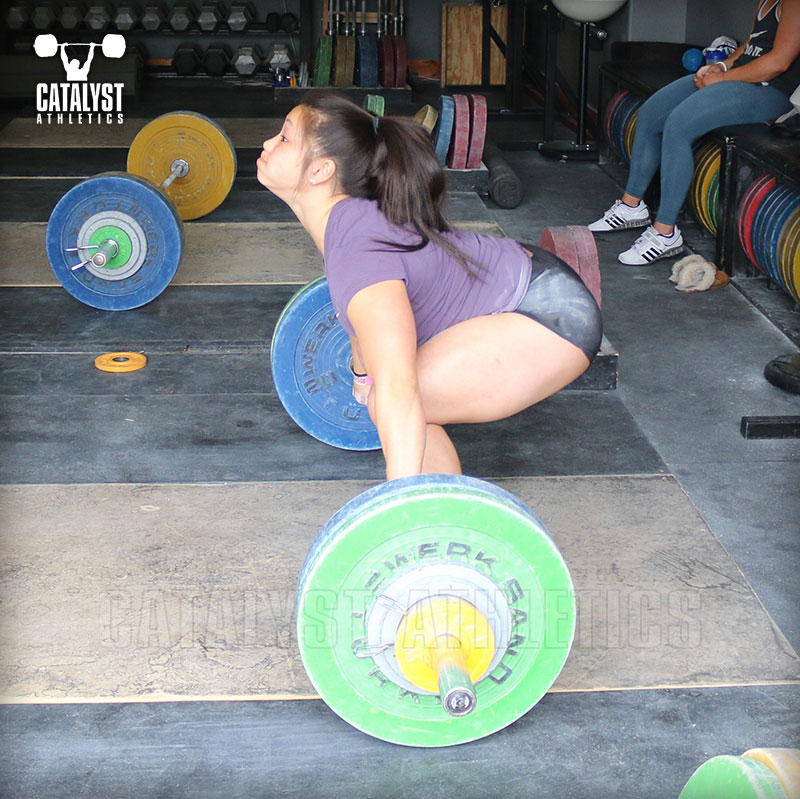Ask Greg: Issue 189

PM Ask
Zac Asks: What are the differences between having a narrower foot position at the start of a snatch versus wider? I’ve heard people say before that having too wide of start position doesn’t allow them to get low enough in a squat but also too narrow of a stance causes the feet to have to cover some ground when receiving the bar. Are there benefits/cons to both?
Greg Says: The pulling position of the feet is entirely personal. There are some principles that direct the initial positioning, but there are so many factors that determine what actually works best for a given athlete that they’re of marginal utility at best. In any case, there certainly isn’t a “good” or “bad” position universally—there is less and more effective for an individual.
The standard width places the heels under the hips so that in a standing position the legs are vertical. This accomplishes two simple things: First, it means that the force being generated by pushing against the ground goes completely back up into the bar because it’s working in a straight line rather than some of that force being lost via vector angles in a wider stance. Second, the height of the bar in full extension is maximized by virtue of the body being tallest with that stance, i.e. the legs reach farthest when oriented straight down from the hips.
But a couple important things to keep in mind with regard to these two points: One, the difference in that height of extension between perfectly vertical legs and even a wide pulling stance is minimal—the width of the stance is restricted by the need to keep the legs between the arms, which prevents extreme width like a sumo stance. Two, that same limitation on width means that vector force issues are similarly limited and will make a negligible difference. A further consideration of the latter is that the upward force we’re imparting to the barbell isn’t strictly from leg drive, but also from hip extension, the power of which is unaffected by the width of the feet. In other words, in these terms, the difference between the textbook stance width and the widest an athlete can practically take is not significant.
When determining the most effective pulling stance for an athlete, we’re balancing a list of considerations such as height, proportions and mobility that affect the actual starting position, as well as factors like how that stance influences actions and positions later in the lift, from balance to the transition of the feet when pulling under the bar.
I’d argue that there isn’t a universal effect of any stance with regard to these things—the effects are totally individual. Someone saying a wide pulling stance prevents their getting into a deep squat when receiving the bar is attributing a problem in their receiving position unfairly to the start—the issue is that they’re not moving into the proper receiving position, which can be done from any starting position. It’s entirely possible to even move narrower from the pulling to receiving position if that’s what works best.
The distance the feet need to move from one position to the other is a potential concern, although I’d argue further that with proper lift execution, there’s no possible distance that should be impossible or even particularly difficult to cover—it’s never that much, and the feet can be moved incredibly quickly. Think about what a common error it is for lifters to inadvertently throw their feet out too wide when receiving snatches in particular—if covering that much distance were so incredibly demanding, it wouldn’t happen so easily as an accident.
The bottom line is that each stance, pulling and receiving, needs to be determined independently of each other to find what’s optimal for a given lifter, and then that lifter needs practice and train the transition to be able to execute it reliably rather than finding creative rationalizations and excuses for poor execution.
| Greg Everett is the owner of Catalyst Athletics, publisher of The Performance Menu Journal and author of Olympic Weightlifting: A Complete Guide for Athletes & Coaches, Olympic Weightlifting for Sports, and The Portable Greg Everett, and is the writer, director, producer, editor, etc of the independent documentary American Weightlifting. Follow him on Facebook here. |
Article Categories
Sort by Author
Sort by Issue & Date

